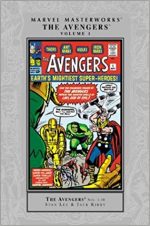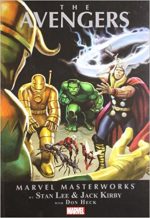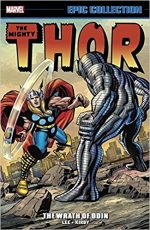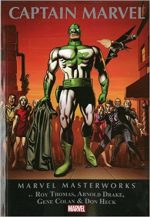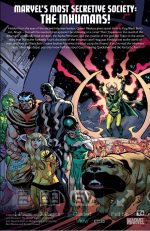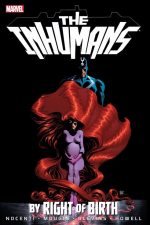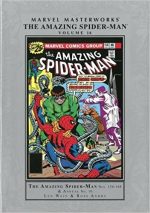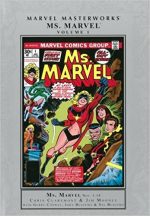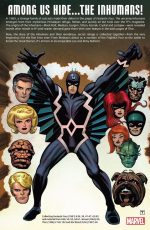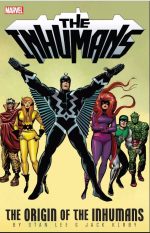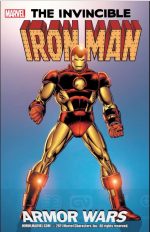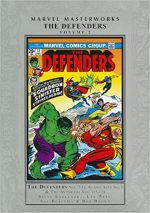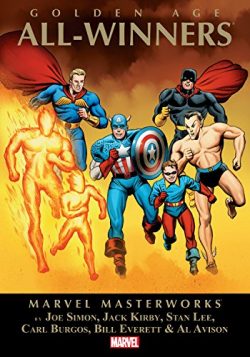
By Joe Simon & Jack Kirby, Stan Lee, Carl Burgos, Bill Everett, Al Avison & others (Marvel)
ISBN: 978-0-7851-6635-1
Unlike their Distinguished Competition, Marvel Comics took quite a while to get into producing expensive archival tomes such as this one reprinting some of their earliest comic adventures. In the cold hard light of day, it’s often fairly clear why.
The sad truth is that much Golden Age Marvel material is not only pretty offensive by modern standards, but is also of rather poor writing and art quality. Something of a welcome exception, however, is this venerable collection of quarterly super-hero anthology All Winners Comics #1-4 – available in hardback, paperback and digital formats.
Over the course of the first year’s publication (from Summer 1941 to Spring 1942) the stories and art varied incredibly (thanks to poor pay rates and the constant call-up of creators to serve overseas), but at least in terms of sheer variety the tales and characters excelled in exploring every avenue of patriotic thrill that might enthral ten-year old boys of all ages.
As well as Simon & Kirby, Lee, Burgos and Everett, the early work of Mike Sekowsky, Jack Binder, George Klein, Paul Gustavson, Harry Sahle, Paul Reinman, Al Avison, Al Gabrielle and many others can be found as they dashed out the adventures of Captain America, Human Torch, Sub-Mariner, Black Marvel, The Angel, The Mighty Destroyer, and The Whizzer.
This spectacular deluxe full-colour compendium opens with a fulsome and informative introduction from Roy Thomas – architect of Marvel’s Golden Age revival – ably abetted by Greg Theakston, detailing the strife and exigencies of churning out fun-fodder under wartime restrictions, after which All Winners Comics #1 commences with Human Torch and flaming kid Toro hunting insidious Japanese agent Matsu as the spy terrorises the peaceful pro-American Orientals of New York’s Chinatown in ‘Carnival of Fiends’ (by Carl Burgos), whilst Stan Lee, Al Avison & Al Gabriele set Indian-reared perfect specimen Black Marvel on the trail of ‘The Order of the Hood’: a well-connected gang of West Coast bandits…
Joe Simon & Jack Kirby then contribute a magnificent Captain America thriller-chiller in ‘The Case of the Hollow Men’: battling a plague of beggars turned into marauding zombies by Nazi super-science.
Stripling Stan Lee & Ed Winiarski contribute a thinly disguised infomercial text tale of ‘All Winners’ after which an untitled Bill Everett Sub-Mariner yarn sees the errant Prince of Atlantis uncover and promptly scupper a nest of saboteurs on the Virginia coastline whilst the inexplicably ubiquitous Angel travels to the deep dark Central American jungle to solve ‘The Case of the Mad Gargoyle’ with typical ruthless efficiency in an engaging end-piece by Alan Mandel
All-Winners #2 was cover-dated Fall 1941 and began with Harry Sahle’s Human Torch thriller ‘Carnival of Death!’ wherein the incendiary android and his mutant sidekick tackle a madly murderous knife-thrower running amok in a winter playground for the wealthy, after which ‘The Strange Case of the Malay Idol’ (Simon & Kirby) finds the Sentinel of Liberty and his youthful aide on a tropical island battling a sinister native death-cult secretly sponsored by the Nazis…
Lee graduates to full comic strips in ‘Bombs of Doom!’ as Jack Binder illustrates the All Winners debut of charismatic, behind-enemy-lines hero The Mighty Destroyer; followed by text feature ‘Winners All’: another Lee puff-piece embellished with a Kirby group-shot of the anthology’s cast before second new guy The Whizzer kicks off a long run with a Lee/Paul Reinman tale of spies and society murderers on the home-front.
After a page of believe-it-or-not ‘Unsolved Mysteries’ a ghost artist illuminates ‘The Ghost Fleet’ to end the issue with another Sub-Mariner versus Nazi submariners all-action romp…
All Winners #3 pits the Torch against Japanese terrorists in ‘The Case of the Black Dragon Society’, a rather over-the-top slice of cartoon jingoism credited to Burgos but scripted by Sahle and drawn by another anonymous ghost squad.
Simon and Kirby had moved to National Comics by this issue and Al Avison was drawing Captain America now – with background inking from George Klein – and scripts by the mysterious S.T. Anley (geddit?), but ‘The Canvas of Doom!’ still rockets along with plenty of dynamite punch in a manic yarn about an artist who predicts murders in his paintings, before The Whizzer busts up corruption and slaughter at ‘Terror Prison’ in a rip-roarer from Lee, Mike Sekowsky & George Klein.
‘Jungle Drums’ is standard genre text filler-fare after which Everett triumphs once more with a spectacular maritime mystery as ‘Sub-Mariner visits the Ship of Horrors’ and The Destroyer turns the Fatherland upside down by wrecking ‘The Secret Tunnel of Death!’ in a blistering epic limned by Chad Grothkopf.
The final issue in this compendium was cover-dated Spring 1942 and – with enough lead time following the attack on Pearl Harbor – the patriotic frenzy mill was clearly in full swing.
A word of warning: though modern readers might well blanch at the racial and sexual stereotyping of the (presumably) well-intentioned propaganda machines which generated tales such as ‘Death to the Nazi Scourge’ and ‘The Terror of the Slimy Japs’, please try to remember the tone of those times and recall that these contents obviously need to be read in an historical rather than purely entertainment context.
The aforementioned ‘Terror of the Slimy Japs’ by Burgos & Sahle has Human Torch and Toro routing Moppino, High Priest of the Rising Sun Temple (and saboteur extraordinaire) from his lair beneath New York, whilst Cap and Bucky content themselves with solving ‘The Sorcerer’s Sinister Secret!’ (Avison & Klein) and foiling another Japanese sneak attack before The Whizzer stamps out ‘Crime on the Rampage’ in a breakneck campaign illustrated by Howard “Johns†nee James.
‘Miser’s Gold’ is just one more genre text tale followed by an Everett inspired-&-guided but ultimately unknown creative team’s take on the other war as ‘Sub-Mariner Combats the Sinister Horde!’ …of Nazis, this time… after which the Destroyer brings down the final curtain by hunting down sadistic Gestapo chief torturer Heinrich Bungler in and declaring ‘Death to the Nazi Scourge!’.
Augmented by covers by Alex Schomburg, Jack Binder & Avison, a string of rousing house ads and other original ephemera, this is a collection of patriotic populist publishing from the dawn of a new and cut-throat industry, working under war-time conditions in a much less enlightened time. That these nascent efforts grew into the legendary characters and brands of today attests to their intrinsic attraction and fundamental appeal, but this is a book of much more than simple historical interest. Make no mistake, there’s still much here that any modern fan can and will enjoy.
© 1941, 1942, 2013, 2017 Marvel Characters, Inc. All rights reserved.

